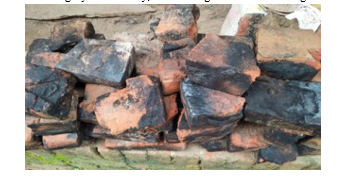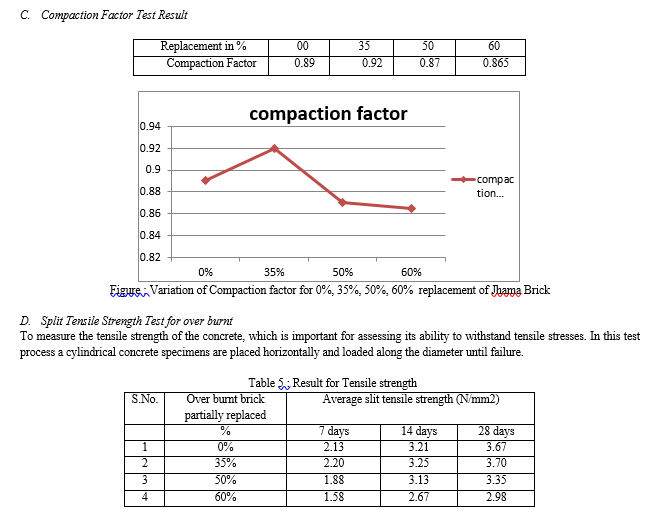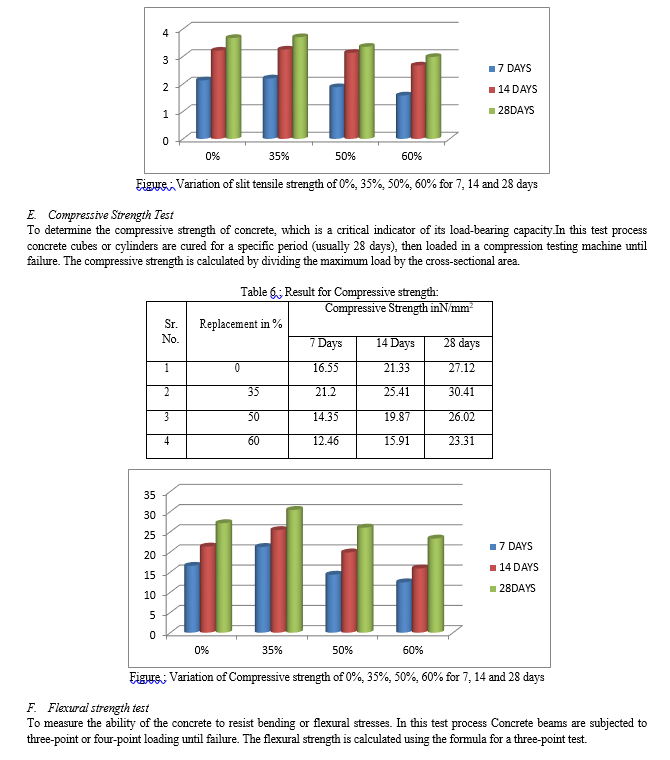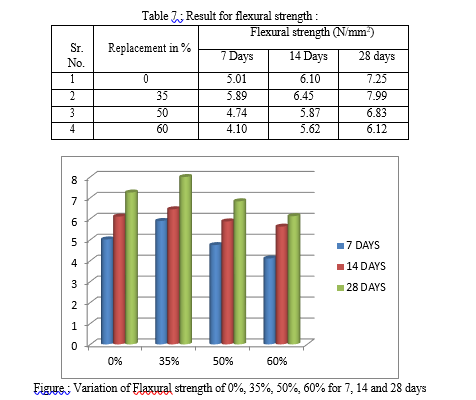Ijraset Journal For Research in Applied Science and Engineering Technology
- Home / Ijraset
- On This Page
- Abstract
- Introduction
- Conclusion
- References
- Copyright
Strength Evaluation of Concrete using Over burnt Brick Stone as Replacement of Coarse Aggregate
Authors: Sameer Ranjan Sahu, Nikhil Soni, Sunil Yadav, Narendra Kumar , Dr. Anil Suman
DOI Link: https://doi.org/10.22214/ijraset.2024.62710
Certificate: View Certificate
Abstract
This research highlights on the behavior of concrete, prepared by the partial replacement of regular aggregate with over-burnt brick aggregate (jhama brick) with a replacing percentages of 0% , 35, 50% & 60% over M20 Grade of concrete which reduces the cost of aggregate (upto 30%) with higher strength, which also results in overall cost in building too .The effect of compressive strength, split tensile strength and flexural strength were reported . The received compaction factor is 0.92, 0.89, 0.88, and 0.87 with varying percentage of (0%, 35%, 50%, 60%) Jhama class brick respectively. This research was conducted to study the suitability crushed over burnt bricks as alternative course aggregates for concrete production. The compressive strength of this concrete is found to be 27.12 , 30.41, 26.02, 23.31 for 0%, 35%, 50%, 60% respectively. The concrete cube, beams and cylinders of M-20 grade were thrown in this trail, explore work and try to analyze different properties of concrete with crushed over burnt bricks as an alternative material. The result shows that the aggregate in concrete derived from Over Burnt bricks aggregate attained relatively higher strength upto the certain percentage and decreases after that, than the regular concrete. More detailed and elaborated work is recommended with different mix ratio and a different proportion of Over Burnt aggregates for a better conclusion.
Introduction
I. INTRODUCTION
Concrete is a composite material formed by mixing cement ,fine aggregate ,coarse aggregate and water in a specific proportion as required in a form of paste. Once mixed, concrete can be poured into molds or formwork and allowed to cure, during which time it gains strength and hardens into a solid mass. After curing, concrete can be finished, polished, or textured to achieve the desired appearance and functionality for various construction projects. The mixing proportion of concrete typically includes the following components by volume:
Cement: 10-15%
Water: 15-20%
Fine aggregate (sand): 25-30%
Coarse aggregate (gravel or crushed stone): 45-50%
These proportions can be adjusted based on factors such as desired strength, workability, and environmental conditions. Additionally, admixtures may be added in small amounts to modify the properties of the concrete mix.
This burnt brick is obtained in the kiln only which is the waste form of brick and is badly distorted in shape and size, black in color, brittle in nature and having high strength.
This brick is distorted into small pieces similar to the size of aggregate. This study aims on the feasibility and effectiveness of the jhama bricks as a supplementary material in concrete construction. By investigating the mechanical properties of jhama brick-concrete composites we are interested in enhancing the strength of the concrete.
Over burned bricks, also known as vitrified bricks, are those that have been subjected to very high temperatures during the firing process, leading to partial melting and a glassy surface. Using over burned bricks in concrete can offer so many advantages , Over burnt bricks are often denser and stronger than regular bricks due to the high firing temperatures.
The aims of the study are
- To develop a mixture proportioning process to manufacture Jhama class brick based concrete.
- To identify and study the effect of salient parameters that affects the properties of Jhama class brick based concrete.
- To study the short-term engineering properties of fresh and hardened Jhama class brick based concrete.
II. REVIEW OF LITERATURE
- Ahmed S.I. Roy (2012)
To study the effect of crushed clay bricks as coarse aggregate on creep behavior of concrete, a comprehensive testing program was conducted. Concrete cylinder specimens having characteristic or specified compressive strength of 17.2, 24.0, and 27.5 MPa were prepared from both natural stone and crushed clay brick aggregate. Mix design ratios were evaluated in a way so that volumetric content of coarse aggregate, both brick and stone, remained same for all concrete samples. Specimens were subjected to creep testing at the 7th and 28th day after casting and creep strain data were recorded up to 300 days. Results show that although strength and other environmental parameters remain the same, concrete made from crushed clay brick as coarse aggregate have a higher creep strain than that of concrete made from natural stone aggregate.
2. Apebo, N. S., Agunwamba, J. C., Ezeokonkwo, J. C.
The concrete mixes were prepared using crushed over burnt bricks as coarse aggregates at water – cement ratios of 0.40, 0.50, 0.55 and 0.60. Cubes of concrete were prepared and tested to study the compressive strength. The results were compared with concrete made with river wash gravel as coarse aggregates which at present is the only coarse aggregate in Makurdi, Nigeria and its environs. The results indicate that crushed over burnt bricks – sand concrete is medium light weight concrete having a density between 2000-2200 kg/m3 and compressive strength of up to 29.5 N/mm2 compared to grave l – sand concrete having density between 2300-2400 kg/m3 and compressive strength of up to 30.8 N/mm2 .
It can be concluded that by reducing the water-cement ratio from 0.60 to 0.40 the compressive strength of crushed over burnt bricks – sand concrete and gravel – sand concrete increase by more than 30%.
3. Jafar Bolouri Bazaz (2012)
During the past decades, in most industrialized countries, a large number of old buildings have been demolished and millions of tons of construction debris have been produced. Demolition wastes around cities have become a serious environmental issue and a threat to underground water quality and result in unpleasant views. Today, less than 5% of clay bricks taken from demolition sites are being separated and recycled, whereas the proportion of concrete waste being recycled is above 90%.
4. Chi-Sun Poon, Dixon Chan (2005)
The use of recycled aggregates for preparing concrete products has been successfully implemented and gaining wider acceptance. However, the allowable level of contaminating materials (e.g., crushed clay bricks, crushed ceramic tiles, waste glass cullet, wood chips, etc.) in the recycled concrete aggregate, in the some of the current specifications, is low (<1%) due to stringent quality control standards that are usually taken from specifications for raw granular virgin materials. This paper presents a recent study on the properties of concrete paving blocks prepared with recycled concrete aggregates that are contaminated by materials (tiles, clay bricks, glass, wood) commonly found in the construction and demolition waste. Eldin N.N., Ahmad B., (1993).
5. Gopinandan Dey and Joyanta Pal (2012)
By far the most common coarse aggregate used in concrete is obtained from natural rock, but type of rock suitable for concrete making is not available everywhere. In Tripura a north-eastern state of India brick aggregate concrete are used conventionally for ordinary concrete due to scarcity of aggregate from natural source. Due to advancement of concrete technology and to fulfill the durability requirement it necessitated to use standard concrete, for which only stone aggregate is used, as a result, cost of construction has been skyrocketed as these are transported from other states. Making good quality concrete with finest sand (grading zone –IV as per Indian code IS:383-1970) is itself a challenge, moreover there is unavailability of natural coarse aggregate locally.
6. Khalaf F.M., Devnny A.S.,(2004),
The recycling of demolished masonry rubble as coarse aggregate in new concrete represents an interesting possibility at a time when the cost of dumping such material is on the increase. With the number of readily accessible disposal sites around major cities in the world decreasing in recent years and disposal volume and maximum sizes of waste being restricted, the cost of dumping construction and demolition debris has increased substantially over recent years. This cost increase has been further fueled in the United Kingdom and other countries by the introduction of a landfill tax by governments and local authorities for the dumping of such waste.
7. Khalaf F.M., Devnny A.S.,(2005),
The testing described in this paper was performed to establish the physical and mechanical properties of new and recycled crushed clay brick aggregates for use in portland cement concrete (PCC). Various physical and mechanical properties of eight different types of aggregates were determined and compared with the limits set out in the British Standards for aggregate from natural sources used in concrete. The results were also compared with granite aggregate that has been proved to be a good natural aggregate for producing PCC. The results showed that most of the crushed clay-brick aggregates tested can be used in producing PCC for low-level civil engineering applications and that some kinds of brick aggregate possess good physical and mechanical properties that qualify them for producing high-quality concrete.
III. MATERIALS AND METHADOLOGY:
A. Materials
- Cement: Cement is the binding agent in concrete. It reacts chemically with water to form a paste that binds the aggregates together. Portland cement is the most common type of cement used in concrete production, but other types such as slag cement and fly ash cement are also used for specific applications.
Table 1: Properties of cement
|
S.No |
characteristics |
Value obtained |
Standard value |
|
1. |
Normal consistency |
32% |
|
|
2. |
Initial setting time |
50 min |
Not less than 30 min |
|
3. |
Final setting time |
255 min |
Not greater than 600 min |
|
4. |
Specific gratity |
3.089 |
|
|
5. |
Fineness |
4.8 |
|
2. Aggregates: Aggregates are granular materials that make up the bulk of concrete. They are divided into two categories: fine aggregates (such as sand) and coarse aggregates (such as gravel or crushed stone). Aggregates provide strength and stability to the concrete mixture and help reduce shrinkage and cracking.
Table 2 : Properties of fine Aggregate
|
S.No. |
Characteristics |
Value |
|
1. |
Type |
Uncrushed |
|
2. |
Specific gravity |
2.68 |
|
3. |
Total water |
1.02% |
|
4. |
Finess modulus |
2.51 |
|
5. |
Grading zone |
2nd |
Table 3 : Properties of coarse Aggregate
|
S.No. |
Characteristics |
Value |
|
1. |
Type |
Crushed |
|
2. |
Maximum size |
20 mm |
|
3. |
Sp. Gr. (20 mm) |
2.80 |
|
4. |
Total water absorption(20mm) |
0.1% |
3. Water: Water is essential for the hydration of cement particles, which allows the cement paste to harden and bind the aggregates together. The water-cement ratio is crucial in determining the strength and durability of the concrete, with a lower water-cement ratio generally resulting in higher strength but potentially lower workability.
4. Admixtures: Admixtures are additional materials added to concrete to modify its properties or improve its performance.
5. Jhama Brick: The normal bricks are burnt up to temperature of 800-900C in the brick kiln. If the temperature in the brick kiln is uncontrolled then the bricks are burnt excessively up to the temperature 1100-1200C. Due to this the bricks are sold at cheaper rate as they become out of shape. Therefore this type of brick is known as over burnt brick. These bricks are also known as Jhama bricks. hama bricks are a type of brick used in construction, especially in regions like India. Over burned bricks are found to be stronger than even the first-class brick. Over burnt bricks have high compressive strength between 120 to 150 Kg/cm2.They are known for their high strength and durability due to the presence of iron oxide in the clay used to make them. In concrete, they provide structural integrity and stability, contributing to the overall strength of the concrete mix.

Table 4 : Properties of concrete
|
S.No. |
Characteristic |
Value |
|
1. |
Compressive strengh |
20 mpa |
|
2. |
Specific gravity |
2.1 |
|
3. |
Water absorption |
6.5% |
|
4. |
Surface Texture |
Rough and Irregular |
B. Mix Ratio
The mix designed was prepared according to the IS-456:2000 recommendation for concrete mix design. 1:2:4 mix proportioning ratio.
IV. METHODOLOGY:-
To manufacture concrete using jhama brick and aggregate, follow steps are cosidered:
- Materials Preparation: Gather jhama bricks, which are rough, irregularly shaped bricks, and aggregate (usually a mix of sand and gravel).
- Crushing Jhama Bricks: Crush the jhama bricks into smaller pieces using a crusher or similar equipment. The crushed jhama brick pieces will act as a coarse aggregate in the concrete mix.
- Mixing: Mix the crushed jhama brick pieces with the aggregate in the desired proportions. Ensure thorough and consistent mixing to achieve uniform distribution of materials.
- Addition of Cement and Water: Add cement and water to the jhama brick and aggregate mixture. The amount of cement and water needed will depend on the desired strength and workability of the concrete.
- Mixing and Blending: Mix the cement, water, jhama brick, and aggregate thoroughly until a homogenous mixture is obtained. Proper blending is essential to ensure uniformity of the concrete mix.
- Placement: Place the mixed concrete into the desired forms or molds, ensuring proper compaction to eliminate voids and air pockets. Proper compaction is crucial for achieving the desired strength and durability of the concrete.
- Curing: Cure the concrete by keeping it moist and at the appropriate temperature for a specified period. This allows the concrete to gain strength and durability over time.
- Finishing: Once the concrete has cured sufficiently, finish the surface as needed, depending on the intended use of the concrete (e.g., smoothing, texturing, or applying coatings).
- Quality Control: Throughout the manufacturing process, perform quality control tests to ensure that the concrete meets the required specifications for strength, durability, and other properties.
By following these steps, manufacture concrete using jhama brick and aggregate effectively.
V. RESULTS AND DISCUSSIONS
A. Consistency Test
To determine the consistency of the fresh concrete mix. Use a slump cone, fill it with concrete in three layers, each tamped 25 times with a rod. Lift the cone and measure the slump. The height difference between the top of the cone and the top of the slumped concrete is measured in millimeters. The result of the slump test is 10mm.
B. Workability Test
To find the workability of Jhama class brick bat based concrete, used the Compaction Factor Test because the compaction factor test gives more information than the other test. The test is a dynamic test and thus is more appropriate than static tests for highly thixotropic concrete mixtures.



Conclusion
On the basis of the result obtained during the experimental investigation, following conclusions were drawn: 1) The compaction factor decreased as the percentage of Jhama class brick increases and increased in comparison with the conventional concrete. 2) It is observed that with increases in percentage of over burnt brick up to 355% it gives higher workability, and workability decreases for 50% to 60% replacement , it gives low workability. 3) 9.01% to 13.72 % increment in the compressive strength is found for 10 to 35 % replacement of coarse aggregate by over burnt brick aggregate, and strength decreases by 3.87% to 28.57 % when the 50% to 60 % of coarse aggregate replaced by over burnt brick aggregate. 4) Split tensile strength of over burnt brick based concrete was higher by 6.25% & 15.62% than that of conventional concrete for replacement of 13.2% & 27%, for further increase in the percentage of replacement up to 50% to 60% ,the split tensile strength decrease by 0.08% & 16.50% respectively. 5) Flexural strength of over burnt brick based concrete was higher by 2.75% & 18.99 than that of conventional concrete for replacement of 10 to 35 %, for further increase in the percentage of replacement up to 50% to 60% , flexural strength decrease 1.29% & 17.20 % respectively. 6) The unit weight also decreased as the percentage of Jhama class brick and decreased in comparison with the conventional concrete. 7) Concrete made by using jhama class brick as a coarse aggregate, initially it gives the higher compressive strength for the replacement 20% and 40% after that it was to decrease for 60%. 8) Reduction in the self wt. of the concrete. 9) There is 10% saving in money if conventional concrete is replaced by over burnt brick aggregate by 35%.
References
[1] Ahmad S.I., Roy s., (2012), ?Creep behavior and its prediction for normal strength concrete made from crushed clay brick as coarse aggregate.? Journal of Material in Civil Engineering, Vol.-24, pp.308-314. [2] Apebo N.S., Agunwamba. J. C.(2014), ? The suitability of crushed over burnt brick as coarse aggregate.?, International Journal of Engineering Science And Innovative Technology, Vol. 3, Issue-1 [3] Bazaz J.B., Khayati M., (2012) ?Properties and Performance of concrete made with recycled low quality crushed brick?,Journal of Material in Civil Engineering. Vol.-24., pp.330-338. [4] Chi-Sun Poon, Dixon Chan.,(2005), ?Effects Of Contaminants On The Properties of Concrete Paving Blocks Prepared with recycled concrete aggregate.?, Construction And Building Materials., pp.164-175 [5] Eldin N.N., Ahmad B., (1993), ?Rubber tire Particle as concrete aggregate.?, Journal of Material in Civil Engineering., Vol.- 5,pp.478-496. [6] Gopinandan Roy, Jayanta pal, (2012), ?Use of Brick Aggregate in Standard Concrete and Its Performance in Elevated Temperature.?, International Journal of Engineering and Technology, Vol. 5, No. 4 IS 10262-2009. [7] Khalaf F.M., Devnny A.S.,(2004), ? Recycling of demolished masonry rubble as coarse aggregate in concrete review.?,Journal of Material in Civil Engineering., Vol.-16,PP.331-340. [8] Khalaf F.M., Devnny A.S.,(2005), ? Properties of new and recycled clay brick aggregate for use in concrete.?, Journal of Material in Civil Engineering., Vol.-17,pp.456-464. [9] Khaldoun Rahal, (2005), ?Mechanical Properties of Concrete With Recycled Coarse Aggregate?, Building And Environmental Science, pp 407-415. [10] Khaloo, A. R. (1994). ?Properties of concrete using clinker brick as coarse aggregate.? ACI Mater. J., 91(4), pp. 401–407.
Copyright
Copyright © 2024 Sameer Ranjan Sahu, Nikhil Soni, Sunil Yadav, Narendra Kumar , Dr. Anil Suman. This is an open access article distributed under the Creative Commons Attribution License, which permits unrestricted use, distribution, and reproduction in any medium, provided the original work is properly cited.

Download Paper
Paper Id : IJRASET62710
Publish Date : 2024-05-25
ISSN : 2321-9653
Publisher Name : IJRASET
DOI Link : Click Here
 Submit Paper Online
Submit Paper Online

